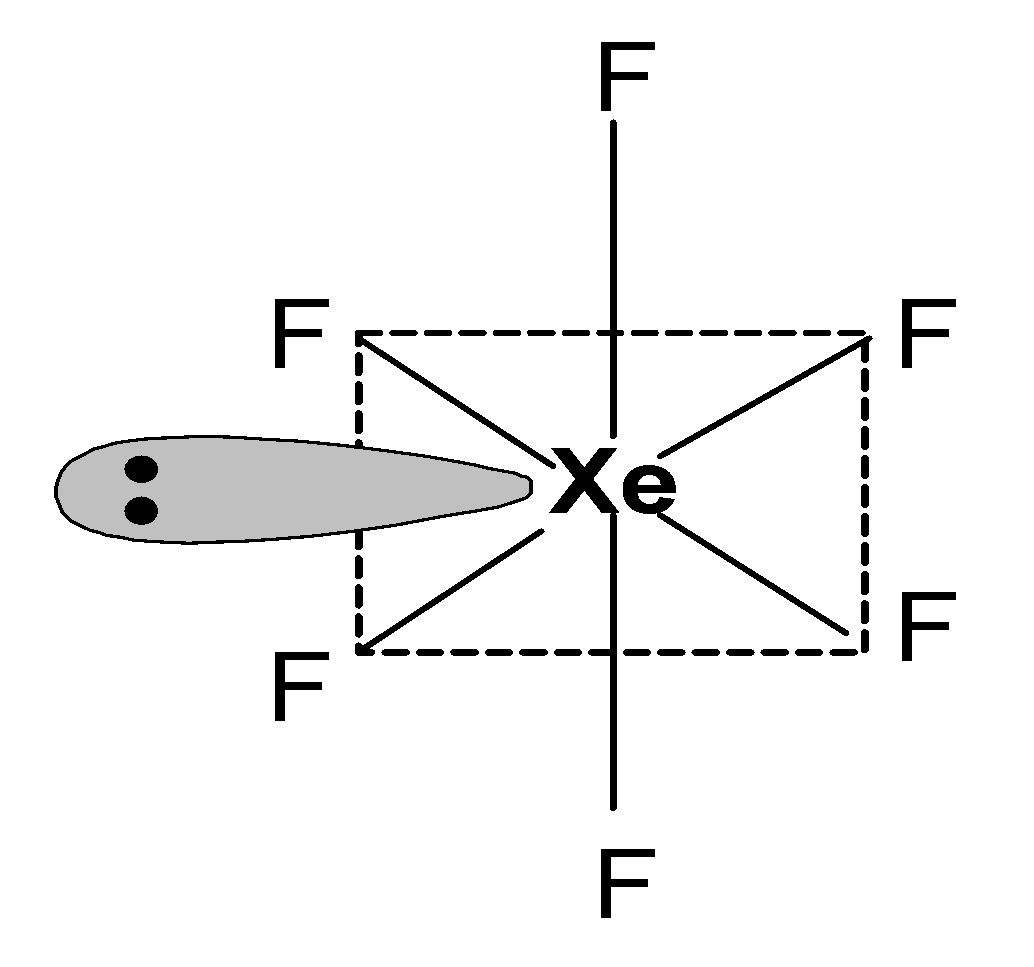
$\text{ Xe}{{\text{F}}_{\text{6}}}\text{ }$ on hydrolysis gives:
A) $\text{ Xe}{{\text{O}}_{\text{3}}}\text{ }$
B) $\text{ Xe}{{\text{O}}_{2}}\text{ }$
C) $\text{ XeO }$
D) $\text{ Xe }$
Answer
462k+ views
Hint: The xenon hexafluoride is a xenon compound. The $\text{ Xe}{{\text{F}}_{\text{6}}}\text{ }$ undergoes the partial or complete hydrolysis reaction. Xenon hexafluoride on hydrolysis gives oxide as a product along with the hydrofluoric acid. The hydrolysis product is a strong oxidizing agent.
Complete Solution :
Xenon is a noble gas element. It is a fifth-period element. The electronic configuration of xenon is as shown below:
$\text{ Xe = }\left[ \text{Kr} \right]4{{\text{d}}^{\text{10}}}\text{ 5}{{\text{s}}^{\text{2}}}\text{ 5}{{\text{p}}^{\text{6}}}\text{ }$
- The valence shell of xenon contains 8 electrons. It also has an empty $\text{ 5d }$ orbital. The six fluorine atoms are bonded to the xenon atom through six covalent bonds and form a xenon hexafluoride compound. Xenon undergoes $\text{ s}{{\text{p}}^{\text{3}}}{{\text{d}}^{\text{3}}}\text{ }$ hybridization and has seven hybrid orbitals. Six hybrid orbitals form a covalent bond with six fluorine atoms and contain one lone pair of electrons.
The structure of xenon hexafluoride is as shown below:

$\text{ Xe}{{\text{F}}_{\text{6}}}\text{ }$ is one of the three binary fluorides formed by xenon.
The xenon hexafluoride undergoes a complete hydrolysis reaction. The hydrolysis of $\text{ Xe}{{\text{F}}_{\text{6}}}\text{ }$ forms a xenon trioxide $\text{ Xe}{{\text{O}}_{\text{3}}}\text{ }$ and hydrofluoric acid $\text{ HF }$ .The reaction between the xenon hexafluoride and water is as shown below:
$\text{ Xe}{{\text{F}}_{\text{6 }}}+\text{ 3}{{\text{H}}_{\text{2}}}\text{O }\to \text{ Xe}{{\text{O}}_{\text{3 }}}+\text{ 6HF }$
The xenon trioxide is highly explosive in nature. It acts as a strong oxidizing agent in the solution.
So, the correct answer is “Option A”.
Note: Note that, the partial hydrolysis of $\text{ Xe}{{\text{F}}_{\text{6}}}\text{ }$ gives oxyfluorides such as $\text{ XeO}{{\text{F}}_{\text{4}}}\text{ }$ and $\text{ Xe}{{\text{O}}_{\text{2}}}{{\text{F}}_{2}}\text{ }$. The reaction of partial hydrolysis of xenon hexafluoride is as follows:
$\text{ }\left. \begin{align}
& \text{Xe}{{\text{F}}_{\text{6}}}\text{ + }{{\text{H}}_{\text{2}}}\text{O }\to \text{ XeO}{{\text{F}}_{\text{4}}}\text{ }+\text{ 2HF } \\
& \text{ Xe}{{\text{F}}_{\text{6}}}\text{ + 2}{{\text{H}}_{\text{2}}}\text{O }\to \text{ Xe}{{\text{O}}_{\text{2}}}{{\text{F}}_{2}}\text{ }+\text{ 4HF} \\
\end{align} \right\}\text{ Partial hydrolysis }$
Complete Solution :
Xenon is a noble gas element. It is a fifth-period element. The electronic configuration of xenon is as shown below:
$\text{ Xe = }\left[ \text{Kr} \right]4{{\text{d}}^{\text{10}}}\text{ 5}{{\text{s}}^{\text{2}}}\text{ 5}{{\text{p}}^{\text{6}}}\text{ }$
- The valence shell of xenon contains 8 electrons. It also has an empty $\text{ 5d }$ orbital. The six fluorine atoms are bonded to the xenon atom through six covalent bonds and form a xenon hexafluoride compound. Xenon undergoes $\text{ s}{{\text{p}}^{\text{3}}}{{\text{d}}^{\text{3}}}\text{ }$ hybridization and has seven hybrid orbitals. Six hybrid orbitals form a covalent bond with six fluorine atoms and contain one lone pair of electrons.
The structure of xenon hexafluoride is as shown below:

$\text{ Xe}{{\text{F}}_{\text{6}}}\text{ }$ is one of the three binary fluorides formed by xenon.
The xenon hexafluoride undergoes a complete hydrolysis reaction. The hydrolysis of $\text{ Xe}{{\text{F}}_{\text{6}}}\text{ }$ forms a xenon trioxide $\text{ Xe}{{\text{O}}_{\text{3}}}\text{ }$ and hydrofluoric acid $\text{ HF }$ .The reaction between the xenon hexafluoride and water is as shown below:
$\text{ Xe}{{\text{F}}_{\text{6 }}}+\text{ 3}{{\text{H}}_{\text{2}}}\text{O }\to \text{ Xe}{{\text{O}}_{\text{3 }}}+\text{ 6HF }$
The xenon trioxide is highly explosive in nature. It acts as a strong oxidizing agent in the solution.
So, the correct answer is “Option A”.
Note: Note that, the partial hydrolysis of $\text{ Xe}{{\text{F}}_{\text{6}}}\text{ }$ gives oxyfluorides such as $\text{ XeO}{{\text{F}}_{\text{4}}}\text{ }$ and $\text{ Xe}{{\text{O}}_{\text{2}}}{{\text{F}}_{2}}\text{ }$. The reaction of partial hydrolysis of xenon hexafluoride is as follows:
$\text{ }\left. \begin{align}
& \text{Xe}{{\text{F}}_{\text{6}}}\text{ + }{{\text{H}}_{\text{2}}}\text{O }\to \text{ XeO}{{\text{F}}_{\text{4}}}\text{ }+\text{ 2HF } \\
& \text{ Xe}{{\text{F}}_{\text{6}}}\text{ + 2}{{\text{H}}_{\text{2}}}\text{O }\to \text{ Xe}{{\text{O}}_{\text{2}}}{{\text{F}}_{2}}\text{ }+\text{ 4HF} \\
\end{align} \right\}\text{ Partial hydrolysis }$
Recently Updated Pages
Master Class 10 General Knowledge: Engaging Questions & Answers for Success

Questions & Answers - Ask your doubts

Master Class 11 Accountancy: Engaging Questions & Answers for Success

Master Class 10 Computer Science: Engaging Questions & Answers for Success

Master Class 11 Science: Engaging Questions & Answers for Success

Master Class 10 Science: Engaging Questions & Answers for Success

Trending doubts
Draw a diagram of nephron and explain its structur class 11 biology CBSE

Why was the Vernacular Press Act passed by British class 11 social science CBSE

Differentiate between calcination and roasting class 11 chemistry CBSE

A solution of a substance X is used for white washing class 11 chemistry CBSE

What is spore formation class 11 biology CBSE

Nastic movement differ from tropical movement in being class 11 biology CBSE




